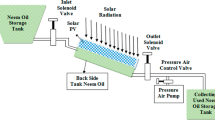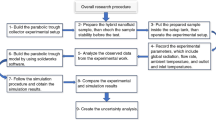Abstract
Suitable thermal management of photovoltaic (PV) modules can increase their efficiency. Alongside, the extra amount of energy needed for their thermal management should also be minimized to improve the overall efficiency of the PV system. This leads to exploring passive thermal management techniques. Recently, radiative cooling (RC) has been explored widely as a passive thermal management technique for PV systems. This paper explores radiative cooling and heat sink (HS) as passive methods for thermal regulation of the photovoltaic systems to get lower and uniform temperature distribution along the PV module. A comprehensive two-dimensional model of the proposed system is developed and analyzed in commercial COMSOL Multiphysics software. The governing equations are solved numerically using finite element methods, and simulations are carried out. Four different configurations, namely Case-0: photovoltaic-only system, Case-1: photovoltaic + heat sink, Case-2: photovoltaic + radiative cooling, and Case-3: photovoltaic + heat sink + radiative cooling systems, are considered in this analysis. The performance of four cases has been compared regarding PV temperature reduction, power output, and conversion efficiency. The performance analysis is carried out for the climatic conditions of the Atacama Desert. The results indicated that the photovoltaic + heat sink + radiative cooling system, i.e., Case-3, is the most efficient among all cases. The reduction in the maximum PV operating temperature and improvements in the maximum PV power output and minimum PV conversion efficiency of the photovoltaic + heat sink + radiative cooling system compared to that of the photovoltaic system alone are 6.63%, 8.57%, and 11.11%, respectively. The findings of this study can be used to effectively design the cooling system for the thermal management of photovoltaic modules installed in desert locations.









Similar content being viewed by others
Abbreviations
- A :
-
Area (m2)
- c p :
-
Specific heat capacity (J kg−1 K−1)
- c 0 :
-
Speed of light in vacuum (m s−1)
- c 2 :
-
Constant
- e :
-
Emissive power (W m−2)
- E :
-
Input energy (W m−2)
- F ext :
-
External incident radiation
- FEPi :
-
Fractional blackbody emissive power
- g :
-
Gravitational acceleration (m s−2)
- G :
-
Solar radiation (W m−2)
- h P :
-
Planck constant (J s)
- h c :
-
Convective heat transfer coefficient (W m−2 K−1)
- H :
-
Enthalpy (J kg−1)
- J :
-
Radiosity (W m−2)
- k :
-
Thermal conductivity (W m−1 K−1)
- k b :
-
Boltzmann constant (J K−1)
- L :
-
Length (m)
- n :
-
Unit vector
- Pr :
-
Prandtl number
- Q :
-
Heat transfer rate (W)
- q :
-
Heat flux (W m−2)
- q i :
-
Internal heat generation per unit volume (W m−3)
- Re :
-
Reynolds number
- t :
-
Time (hr)
- T :
-
Temperature (K)
- u :
-
Fluid velocity (m s−1)
- V :
-
Volume (m3)
- α :
-
Absorptivity
- β :
-
Temperature coefficient of efficiency (K−1)
- ε :
-
Surface emissivity
- ρ :
-
Density (kg m−3)
- σ :
-
Stefan–Boltzmann constant (W m−2 K−4)
- τ :
-
Transmissivity
- λ :
-
Wavelength (m)
- ρ d :
-
Diffuse reflectivity
- μ :
-
Dynamic viscosity (kg ms−1)
- θ :
-
Inclination angle
- ƞ :
-
Efficiency
- \(\nabla\) :
-
Difference
- amb:
-
Ambient
- b:
-
Blackbody
- ext:
-
External
- i:
-
i-th Layer
- j:
-
Layer above the ith layer
- m:
-
Mutual
- PV:
-
Photovoltaic
- p:
-
Constant pressure
- ref:
-
Reference
- sun:
-
Sun
- x:
-
x Direction
- y:
-
y Direction
- CPV:
-
Concentrated photovoltaic
- HS:
-
Heat sink
- PV/T:
-
Photovoltaic/thermal
- PV:
-
Photovoltaic
- RC:
-
Radiative cooling
- TEG:
-
Thermoelectric generator
References
Chandel SS, Naik MN, Sharma V, Chandel R. Degradation analysis of 28 year field exposed mono-c-Si photovoltaic modules of a direct coupled solar water pumping system in western Himalayan region of India. Renew Energy. 2015;1(78):193–202.
Du D, Darkwa J, Kokogiannakis G. Thermal management systems for photovoltaics (PV) installations: a critical review. Sol Energy. 2013;1(97):238–54.
Li Y, Witharana S, Cao H, Lasfargues M, Huang Y, Ding Y. Wide spectrum solar energy harvesting through an integrated photovoltaic and thermoelectric system. Particuology. 2014;1(15):39–44.
Ding LC, Akbarzadeh A, Tan L. A review of power generation with thermoelectric system and its alternative with solar ponds. Renew Sustain Energy Rev. 2018;1(81):799–812.
Shukla A, Kant K, Sharma A, Biwole PH. Cooling methodologies of photovoltaic module for enhancing electrical efficiency: a review. Sol Energy Mater Sol Cells. 2017;1(160):275–86.
Hegedus S, Luque A, editors. Handbook of photovoltaic science and engineering. John Wiley & Sons, 2011.
King DL, Eckert PE. Characterizing (rating) the performance of large photovoltaic arrays for all operating conditions. In: Conference record of the twenty fifth IEEE photovoltaic specialists conference, 1996; 1385–1388. IEEE.
Moshfegh B, Sandberg M. Flow and heat transfer in the air gap behind photovoltaic panels. Renew Sustain Energy Rev. 1998;2(3):287–301.
Teo HG, Lee PS, Hawlader MN. An active cooling system for photovoltaic modules. Appl Energy. 2012;90(1):309–15.
Chen H, Yang J, Zhou N, Chen J, Zhang Y. Performance analysis of a high concentrating photovoltaic/thermal system with a water spray cooling device. Mater Sci Eng. 2019;556(1):012034.
Nižetić S, Papadopoulos AM, Giama E. Comprehensive analysis and general economic-environmental evaluation of cooling techniques for photovoltaic panels, Part I: Passive cooling techniques. Energy Convers Manag. 2017;1(149):334–54.
Nižetić S, Giama E, Papadopoulos AM. Comprehensive analysis and general economic-environmental evaluation of cooling techniques for photovoltaic panels, Part II: active cooling techniques. Energy Convers Manag. 2018;1(155):301–23.
Najafi H, Woodbury KA. Optimization of a cooling system based on Peltier effect for photovoltaic cells. Sol Energy. 2013;1(91):152–60.
Bahaidarah HM, Baloch AA, Gandhidasan P. Uniform cooling of photovoltaic panels: a review. Renew Sustain Energy Rev. 2016;1(57):1520–44.
Yuan J, Zhang K, Zhao D, Yin X, Yang R, Tan G. Energy saving analysis of a metamaterial based radiative cooling system for low-rise residential buildings by integrating with radiant floor. In: ASTFE Digital Library 2018. Begel House Inc..
An Y, Sheng C, Li X. Radiative cooling of solar cells: Opto-electro-thermal physics and modeling. Nanoscale. 2019;11(36):17073–83.
Ahmed S, Li Z, Ma T, Javed MS, Yang H. A comparative performance evaluation and sensitivity analysis of a photovoltaic-thermal system with radiative cooling. Sol Energy Mater Sol Cells. 2021;1(221):110861.
Li Z, Ahmed S, Ma T. Investigating the effect of radiative cooling on the operating temperature of photovoltaic modules. Solar RRL. 2021;5(4):2000735.
Ahmed S, Li S, Li Z, Xiao G, Ma T. Enhanced radiative cooling of solar cells by integration with heat pipe. Appl Energy. 2022;15(308):118363.
Comsol Multiphysics. Heat transfer module. Retrieved March 27, 2023, from https://doc.comsol.com/6.1/docserver/#!REF:%252Fcom.comsol.help.heat%252Ftoc.xml:RES:res_toc_613802992.html
Nasef HA, Nada SA, Hassan H. Integrative passive and active cooling system using PCM and nanofluid for thermal regulation of concentrated photovoltaic solar cells. Energy Convers Manage. 2019;1(199):112065.
Lorenzi B, Acciarri M, Narducci D. Analysis of thermal losses for a variety of single-junction photovoltaic cells: An interesting means of thermoelectric heat recovery. J Electron Mater. 2015;44:1809–13.
Zhai Y, Ma Y, David SN, Zhao D, Lou R, Tan G, Yang R, Yin X. Scalable-manufactured randomized glass-polymer hybrid metamaterial for daytime radiative cooling. Science. 2017;355(6329):1062–6.
Comsol Multiphysics. The Radiosity method for diffuse-gray surfaces. Retrieved October 27, 2022, from https://doc.comsol.com/6.0/docserver/#!/com.comsol.help.heat/heat_ug_theory.07.47.html?highlight=radiosity
Salari A, Kazemian A, Ma T, Hakkaki-Fard A, Peng J. Nanofluid based photovoltaic thermal systems integrated with phase change materials: numerical simulation and thermodynamic analysis. Energy Convers Manag. 2020;1(205):112384.
Kumar R, Montero FJ, Lamba R, Vashishtha M, Upadhyaya S. Thermal management of photovoltaic-thermoelectric generator hybrid system using radiative cooling and heat pipe. Appl Therm Eng. 2023;5(227):120420.
Lamba R, Montero FJ, Rehman TU, Singh S, Manikandan S. PCM-based hybrid thermal management system for photovoltaic modules: A comparative analysis. Environ Sci Pollut Res. 2023; 5:1–20.
Lamba R, Montero FJ, Kumar R, Choudhary AK, Vashishtha M, Upadhyaya S. Effect of Phase Change Material on Thermal Management of Photovoltaic System. Int Conf Adv Energy Res. 2022; Jul 7 (pp. 819–827). Singapore: Springer Nature Singapore.
Rejeb O, Lamrani B, Lamba R, Kousksou T, Salameh T, Jemni A, Hamid AK, Bettayeb M, Ghenai C. Numerical investigations of concentrated photovoltaic thermal system integrated with thermoelectric power generator and phase change material. J Energy Storage. 2023; Jun 1;62:106820.
Author information
Authors and Affiliations
Corresponding author
Additional information
Publisher's Note
Springer Nature remains neutral with regard to jurisdictional claims in published maps and institutional affiliations.
Rights and permissions
Springer Nature or its licensor (e.g. a society or other partner) holds exclusive rights to this article under a publishing agreement with the author(s) or other rightsholder(s); author self-archiving of the accepted manuscript version of this article is solely governed by the terms of such publishing agreement and applicable law.
About this article
Cite this article
Kumar, R., Montero, F.J., Rehman, Tu. et al. Radiative cooling system integrated with heat sink for the thermal management of photovoltaic modules under extreme climate conditions. J Therm Anal Calorim 148, 9099–9112 (2023). https://doi.org/10.1007/s10973-023-12291-1
Received:
Accepted:
Published:
Issue Date:
DOI: https://doi.org/10.1007/s10973-023-12291-1




